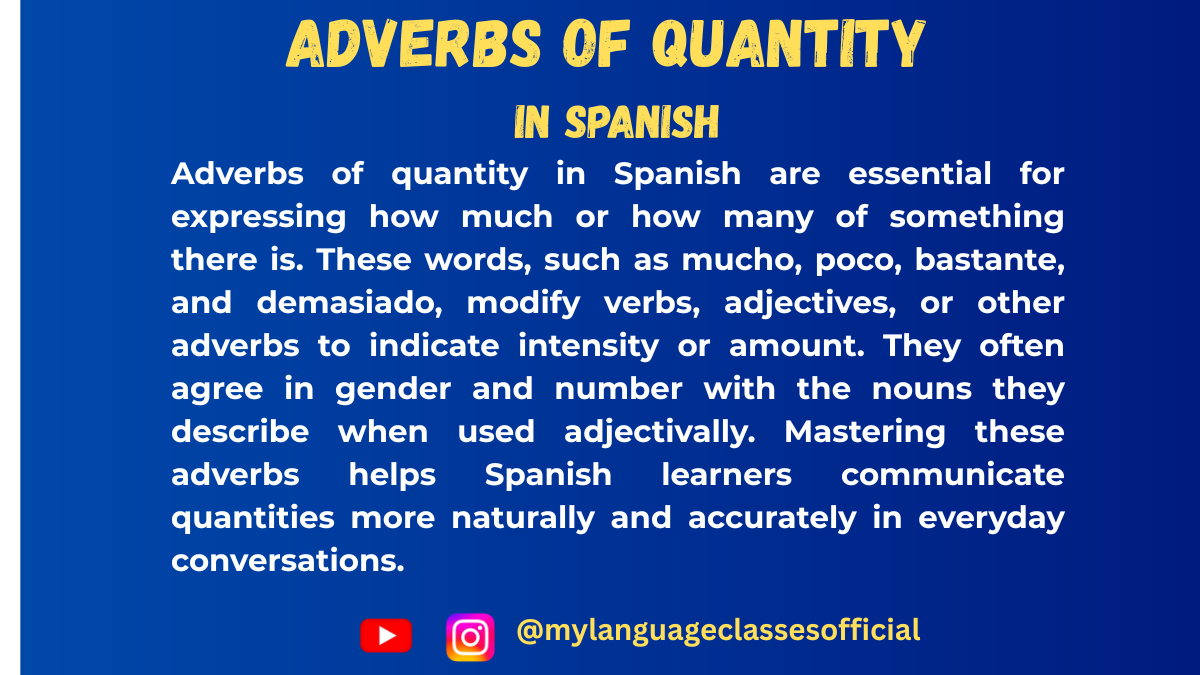Your cart is currently empty!
Tag: how to use adverbs of quantity in Spanish sentences
-

Adverbs of Quantity in Spanish
In Spanish, adverbs of quantity are essential for expressing the degree or intensity of an action, quality, or quantity. They modify verbs, adjectives, and other adverbs. Understanding their usage is crucial for fluency, as they help convey precise meaning in various contexts. In this blog post, we will explore common Spanish adverbs of quantity, their meanings, rules for usage, and examples to illustrate their practical applications.
Common Adverbs of Quantity and Their Meanings
Spanish Adverb Meaning Mucho A lot, much, many Poco Little, few Bastante Enough, quite a bit Demasiado Too much, too many Algo Some, a little Nada Nothing Todo All Casi Almost Más More Menos Less Suficiente Sufficient, enough Excesivamente Excessively Aproximadamente Approximately
How to Use Adverbs of Quantity in Spanish
1. When Modifying Verbs
- Adverbs of quantity typically follow the verb they modify.
- Example:
- Trabajo mucho. (I work a lot.)
- Habla poco. (He/She speaks little.)
2. When Modifying Adjectives and Other Adverbs
- They usually come before the adjective or adverb.
- Example:
- Es demasiado caro. (It is too expensive.)
- Ella es bastante inteligente. (She is quite intelligent.)
3. When Modifying Nouns
- Some adverbs of quantity function as determiners and must agree in gender and number with the noun.
- Example:
- Tengo muchos amigos. (I have many friends.)
- Hay pocas sillas en la sala. (There are few chairs in the room.)
- Comimos demasiadas frutas. (We ate too many fruits.)
Things to Keep in Mind
1. Agreement with Gender and Number
- Adverbs such as mucho, poco, bastante, demasiado, suficiente must agree with the noun when used as determiners.
- Singular masculine: mucho dinero (a lot of money)
- Singular feminine: mucha agua (a lot of water)
- Plural masculine: muchos libros (many books)
- Plural feminine: muchas personas (many people)
2. Difference Between Adverbs and Adjectives
- When used with a noun, these words function as adjectives and must agree in number and gender.
- When used with a verb, they remain invariable as adverbs.
- Example:
- Ella trabaja mucho. (She works a lot.) – Adverb
- Ella tiene muchas tareas. (She has many tasks.) – Adjective
3. Avoiding Overuse of “Demasiado”
- “Demasiado” often implies excess and can carry a negative connotation.
- Example:
- Bebes demasiado café. (You drink too much coffee.) – Possible negative implication
- Bebes bastante café. (You drink quite a bit of coffee.) – Neutral tone
Forming Adverbs of Quantity
1. Regular Formation
- Many adverbs of quantity are derived from adjectives by adding -mente to the feminine form of the adjective.
- Example:
- Excesivo → Excesivamente (Excessively)
- Aproximado → Aproximadamente (Approximately)
2. Irregular Forms
- Some adverbs do not follow the regular formation pattern.
- Example:
- Mucho (A lot) – No change
- Poco (Little) – No change
- Demasiado (Too much) – No change
Common Expressions with Adverbs of Quantity
Expression Meaning Example Más o menos More or less La película fue más o menos interesante. (The movie was more or less interesting.) Por lo menos At least Necesitamos por lo menos dos horas. (We need at least two hours.) Ni mucho menos Not at all No es verdad, ni mucho menos. (It’s not true at all.) Nada más Nothing else, just Quiero nada más un café. (I just want a coffee.) Poco a poco Little by little Aprenderás español poco a poco. (You will learn Spanish little by little.) Mucho gusto Nice to meet you Mucho gusto en conocerte. (Nice to meet you.) Demasiado tarde Too late Llegaste demasiado tarde. (You arrived too late.)
Conclusion
Mastering adverbs of quantity in Spanish is essential for expressing intensity and quantity with precision. Remember to pay attention to their placement and agreement when necessary. Whether you’re saying “trabajo mucho” (I work a lot) or “hay demasiadas opciones” (There are too many options), using these adverbs correctly will greatly improve your Spanish fluency.
Practice incorporating these adverbs into your daily conversations and written Spanish to become more confident in their usage. ¡Buena suerte!
Would you like more practice exercises or a quiz to test your understanding? Let me know in the comments!
If you enjoyed this lesson, be sure to check out more posts like this on my blog at My Language Classes. Don’t forget to subscribe my YouTube channel and follow me on Instagram for the latest language learning tips and lessons. Leave a comment below to share your thoughts, or ask any questions you have.
Happy learning! 😊
📚 Continue Learning Spanish
Share this:
- Click to share on Facebook (Opens in new window) Facebook
- Click to share on X (Opens in new window) X
- More
- Click to email a link to a friend (Opens in new window) Email
- Click to share on LinkedIn (Opens in new window) LinkedIn
- Click to share on Reddit (Opens in new window) Reddit
- Click to share on Tumblr (Opens in new window) Tumblr
- Click to share on Pinterest (Opens in new window) Pinterest
- Click to share on Pocket (Opens in new window) Pocket
- Click to share on Telegram (Opens in new window) Telegram
- Click to share on Threads (Opens in new window) Threads
- Click to share on WhatsApp (Opens in new window) WhatsApp
- Click to share on Mastodon (Opens in new window) Mastodon
- Click to share on Nextdoor (Opens in new window) Nextdoor
- Click to share on Bluesky (Opens in new window) Bluesky
